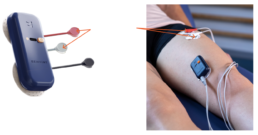
Correct placement of the electrodes in an electromyography (EMG) scan is essential to obtain accurate measurements of the electrical activity of the muscles. Here is a guide on how to place the three electrodes of an EMG:
- Identify the muscle you wish to record.
- Place the first electrode (the black ground electrode) on a non-active area of muscle, usually close to the area you are recording. This serves as a reference for the electrical activity.
- Place the other two electrodes (red and white) on either side of the area of interest.
A few principles to increase the quality of the recording:
- Make sure the chosen site is close to the targeted muscle mass to minimise the layer of tissue between the electrodes and the muscle fibres.
- Position the electrodes in line with the muscle fibres, preferably parallel, to improve sensitivity and specificity. Electrodes placed perpendicular to the fibres may result in lower selectivity.
- Avoid the motor plate region. Electrodes placed there often record reduced amplitudes due to differential amplification. The preferred position for electrodes is in the middle of the muscle belly between an innervation zone and the myotendinous junction, in alignment with the muscle fibres.
- Choose locations with distinct anatomical landmarks, facilitating consistent electrode placement in subsequent sessions.

- Select sites that do not interfere with vision or movement, and avoid problem areas such as skin folds, bony prominences and other obstructions.
- Limit interference from neighbouring muscles by choosing the right electrode size and spacing.
